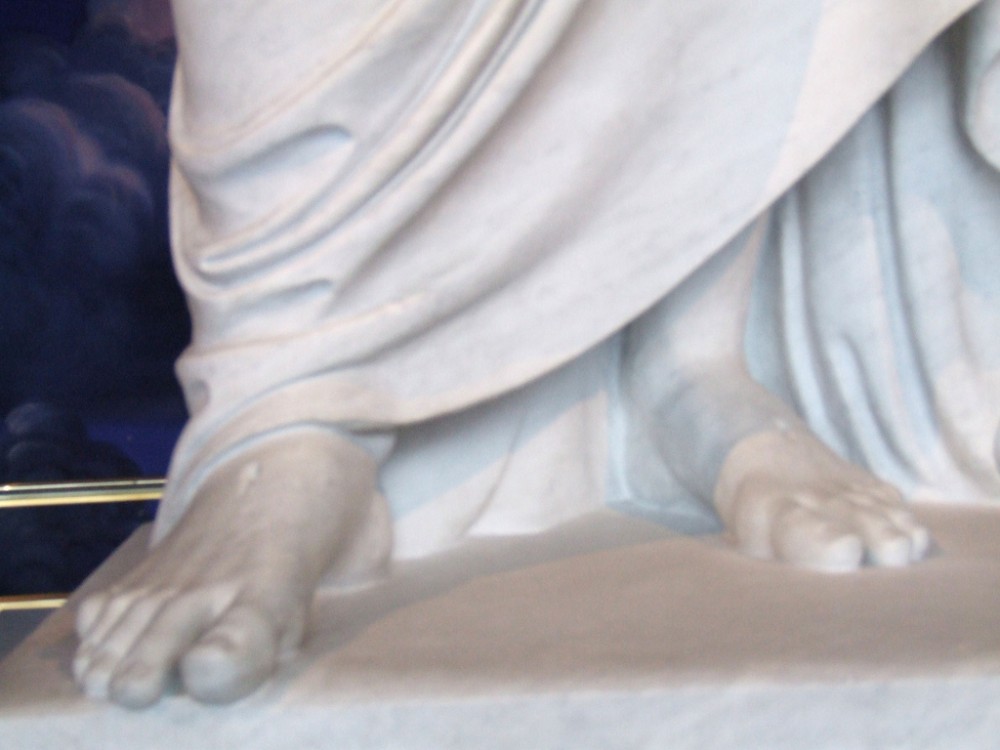Christ both there and here
On Ascension Day, with the readings from Luke and Acts in danger of being embalmed by archaism, the reading from Ephesians is a gift.

There is arguably no festival or Sunday of the Christian year that is more dependent on mythic imagery than the Ascension of the Lord. The superb narrator Luke is the only New Testament writer to literalize an account of the ascension. Although in the final chapter of his Gospel Luke describes the ascension as occurring on Easter Day, in the Acts of the Apostles he introduces the imagery of 40 days to intensify his story line.
In the scriptures, it is for 40 days that rain falls on Noah’s ark, that the spies scout out Canaan, that Goliath taunts the Israelite army, that Ezekiel lies on his right side, that Nineveh is threatened with destruction, and that Jesus is tempted after his baptism. At age 40 Moses murders an Egyptian; 40 years later he meets with God on Mount Sinai; and 40 years later he dies. For 40 years Israel wanders in the desert and for 40 years suffers under the Philistines. Saul, David, and Solomon each reign 40 years, and every woman is secluded for 40 days after the birth of a son.
Read our latest issue or browse back issues.
Perhaps the origin of this metaphor lies in the fact that 40 exceeds the lunar pacing of 30 days. Forty is a long time. But 40 is also mythically alive, a time pregnant with a religious future. Forty is how long we must wait for God’s intent to be realized. Forty is the metaphysical delay which all humans experience, the legendary period of hope, the duration of either joy or sorrow that opens to emotions unknown. It often takes 40 to open the door.
Christians adopted Luke’s chronology, whether because they accepted the historicity of a literal event on the hill near Jerusalem or because they knew that even after the transformation of Christ’s resurrection, we need to wait yet longer for its full manifestation. The mobs that worshiped on Easter Day have gone back home, and we do not yet see the universe made new.
“Heaven” is a second mythic image of the ascension. The scriptures assume a three-tier universe, with the dead below, the divine powers up above, and the living in the midst. Some biblical poetry pictures the might of the universe beyond our knowing as if it were a throne room in the skies. In the Bible, “heaven” or “the heavens” sometimes means only “sky”; other times it refers to the source, perhaps the distant location, of God’s unmediated presence. For Matthew, “heaven” is a circumlocution for God. Medieval mystics expressed their hope that after death, in heaven, they would see God.
In the 19th century heaven became summer camp with your dead grandmother. For many people in our time, Plato has won: there may be no God, say countless contemporary Westerners, but after death the soul will enjoy a heaven. This archaic cosmology remains alive in our consciousness, believers and nonbelievers alike speaking as if God is up there. And our creeds maintain the mythic imagery by situating the risen Christ “at the right hand of the Father.”
Like all magnificent metaphors, the picture is engaging: a seated deity surrounded with supernatural powers, Jesus the prime minister as God’s right-hand man who rights wrongs and ensures justice and peace finally at the end, or at least at my end. Yet I hope that this mythic imagery can be undergirded with the fifth-century theology of Pope Leo, that Christ has ascended into the sacraments.
Many Christians assume that “the gospel,” the good news of life in Christ, is heard in “the Gospel,” whichever passage from the evangelists is proclaimed at worship. But on Ascension Day, with the readings from Luke and Acts in danger of being embalmed by archaism, the reading from Ephesians is a gift.
Here is the presence of the Trinity: our Lord Jesus Christ, the Father of glory, and the Spirit of wisdom. The community is praised for shared love, and its participants are referred to as “holy ones.” Here is the promise of enlightenment and of access to divine power. Just as the scripture usually offers us two of everything—as with the ascension stories in Luke 24 and in Acts 1—so the author of Ephesians offers a picture of the ascended Christ that is different from Luke’s. Christ spans the universe, for although he is seated in the heights of the universe, highest above all things, he is also the head of his body, which is the church.
Christ is not far away, floating somewhere. How incongruous it is that the altarpieces of many churches depict the disciples looking up toward heaven, precisely as the angels told them not to. However, a green Christianity rejoices to hear that God is not removed from the universe but rather pervades it. The body of Christ is not somehow beyond our telescopes but is here, gathered on a Thursday, constituting “the body of Christ,” who share together the bread that we call “the body of Christ.”
Attending worship on the Ascension of the Lord, some believers will gladly accept this mythic imagery, ignoring the incongruity of its worldview. Others honor such metaphors with the Sunday morning part of their brain, and still others are antsy for the service to conclude, so they can get back to real life. The majority of the baptized will not be present at all, and we will not know whether the day’s mythic imagery has meaning for them. Yet may that “spirit of wisdom” promised by the writer of Ephesians surround them with the reality of Christ’s resurrection.





